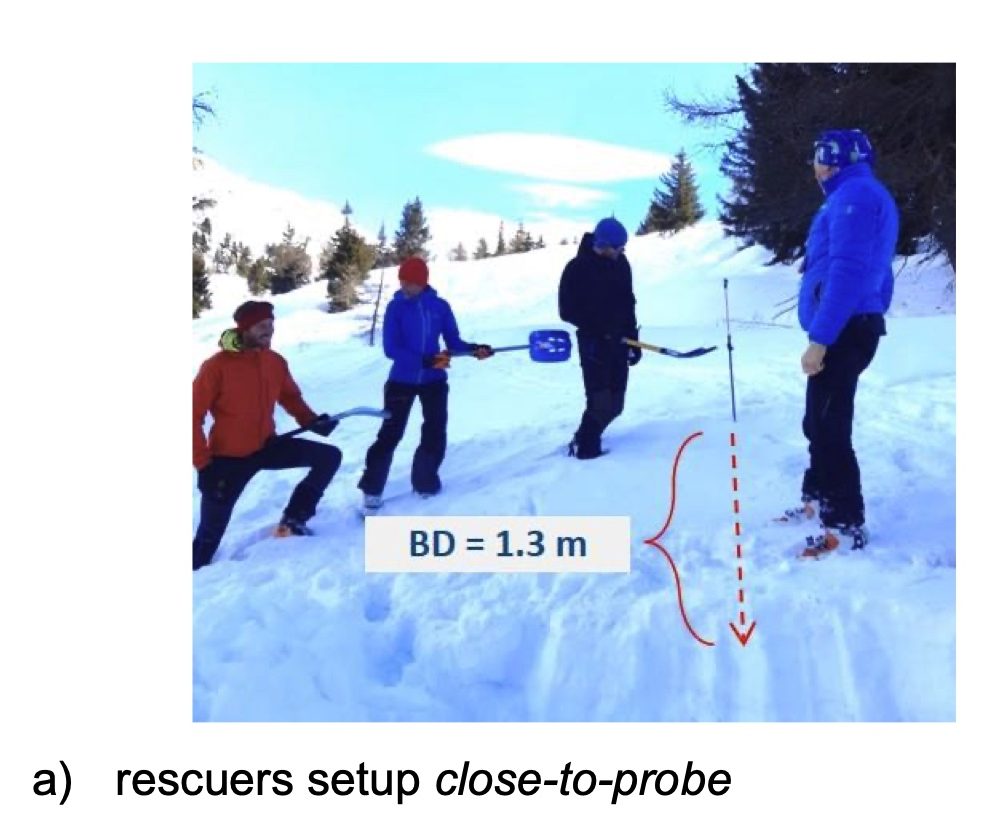At the recently concluded International Snow Science Workshop (ISSW), a paper presented by an Italian group titled “Dig Close, Dig Fast. A Study on the Consequences of Excavation Start Point Choice in Avalanche Companion Rescue,” explores the efficacy of some well-accepted practices relating to removing snow effectively, accessing a buried victim, and exposing their airway.
First, this is serious stuff. Second, we’re here to write about the paper’s findings, not to question avalanche educators or their avalanche rescue curriculum.
To set the scene, imagine there’s a group of four, with one of the four buried under avalanche debris. We’re taught to probe for the victim and keep the probe in place when there’s a victim strike. Next, we should note the victim’s burial depth and begin shoveling on the downhill side of the probe strike in a conveyor belt fashion.
A key tenet of avalanche education is where to start digging. Many educators recommend a dig start point of ~1.5 times the burial depth (again, on the downhill side of the probe strike). As the shoveling proceeds, a gentle ramp is created, which, in best-case scenarios, slopes gently toward the victim.
Still, there’s another variable in play—slope angle. Generally, with higher slope angles, ~> 25-degrees, the dig start point is closer to the probe strike point, ~1 x the burial depth, whereas, in less steep terrain, the dig start point skews to the ~1.5 times the burial depth rule. (For example, in below 25-degree terrain, if a victim is buried under 1.5 meters of debris, the dig start point is ~2.25 meters from the probe strike.)
The Research—Most Effective Dig Start Point
According to the paper’s authors, the Italian Alpine Club (CAI) endorses what they call the “Conveyor Belt” method, which teaches, in most cases, to position the first shoveler, and their dig start point, as one shovel length from the probe.
It’s easy to see the discrepancy between what the Italians practice and what is taught in many North American avalanche education classes. These discrepancies are serious business, considering a buried victim might be desperate for air. Time is of the essence.
The authors established a testing protocol to “measure if and what are the differences in the time required to reach the buried subject when the only variant in the excavation technique is the starting point: either ‘canonical’ (near the probe) or ‘from far.”
To clarify, a dig start point defined as “from far” or “far from pole” equates to “a distance from the probe equal to the burial depth.” The test burial depth was 1.3 meters, on a slope approximating no more than 5-degrees. The “from far” excavation start point was 1.3 meters from the probe strike. Close/near to the probe means an excavation start point a shovel length away. My shovel, a Mammut Alligator Light, measures ~75cm full extended.
Researchers measured the time to reach the “body,” or probe tip, and the time to reach the victim’s airway (a 80cm wide zone by the probe tip).





